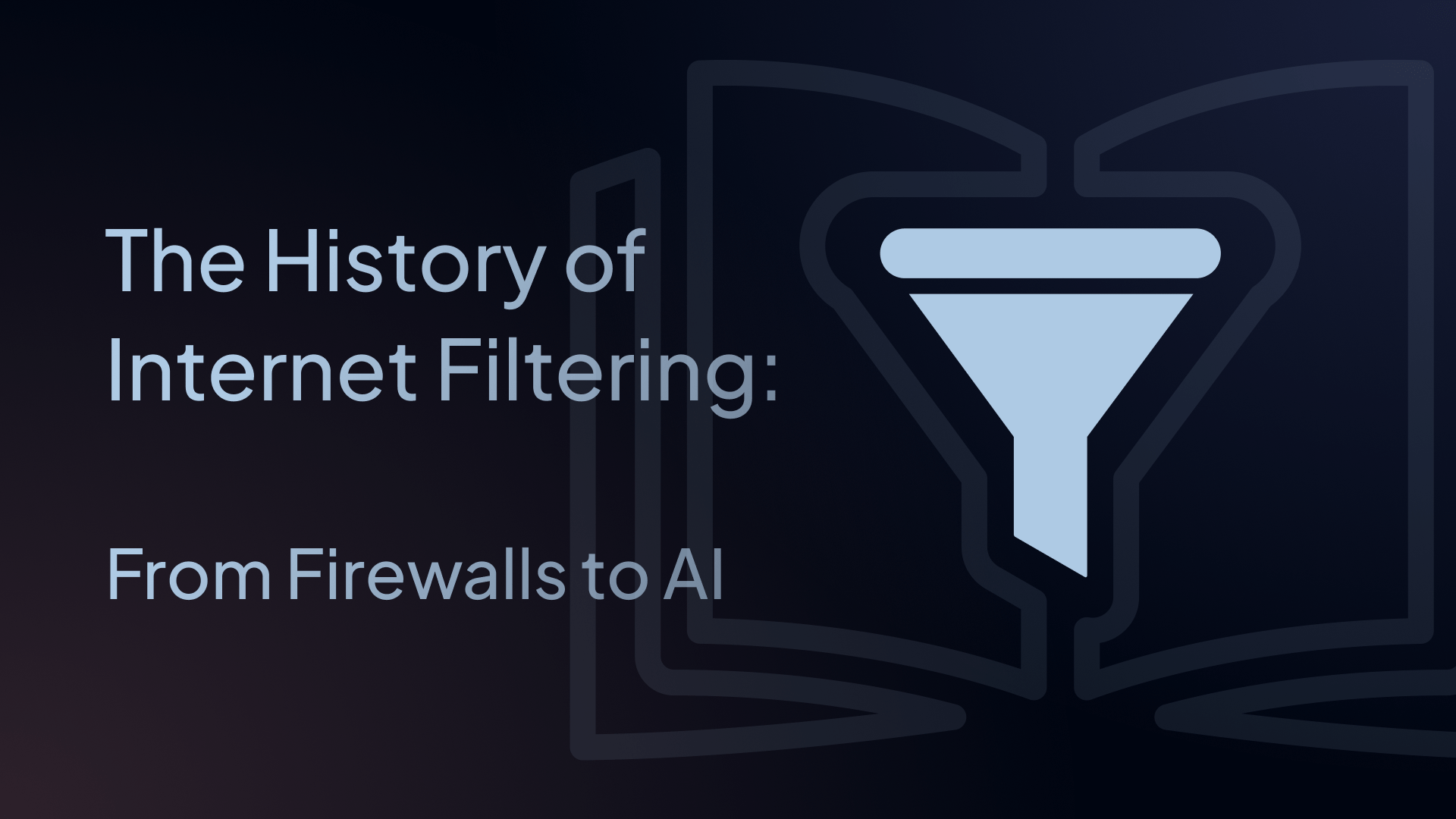The History of Internet Filtering: From Firewalls to AI
Explore the history of internet filtering and learn what a modern, effective filtering stack should look like.

Remember the dial-up screech? Back then, “filtering” mostly meant “don’t click weird links.”
Fast-forward to today, and internet filtering is a multilayered craft that blends network controls, cloud delivery, and, increasingly, AI.
Here’s how we got from castle-wall firewalls to filtering software that classifies a brand-new site in seconds, and what that means for you.
Stage 1: Castle Walls & the Wild West (Late ’80s–’90s)
When the commercial internet was still a novelty, security looked like medieval architecture: packet-filtering firewalls that allowed or denied traffic based on IP addresses, ports, and protocols.
It was great at keeping outsiders at bay, but not so great at deciding whether example.com/cats was wholesome while example.com/malware was not. Policies also lived in long Access Control Lists (ACLs), which a few brave admins managed.
Then the web went mainstream, and the human worries arrived: parents concerned about adult content, schools and institutions about liability.
The first wave of filters appeared, primarily consisting of keyword blockers and hand-built URL lists, which were famously blunt. Think pages about breast cancer resources getting flagged as “adult.”
Firewalls focused on who/what can connect, whereas filters decided which content was appropriate. They evolved as complementary layers, not replacements.
Stage 2: Proxies & URL Blacklists (Late ’90s–Early ’00s)
Next came web proxies and the first URL filtering: big databases that labeled sites into categories, such as adult, gambling, malware, and violence.
Businesses rolled out secure web gateways, schools enforced “acceptable use,” and parents discovered parental control software. For the first time, filtering felt human-readable: “block adult content,” not “deny TCP/80 from 0.0.0.0/0.”
In 2000, the Children's Internet Protection Act (CIPA) required U.S. K-12 schools and public libraries receiving certain federal funding to use internet filtering, accelerating adoption and fueling ongoing debates about internet access vs. censorship.
- Strengths: category-based rules, cache-boosted performance, clear block pages.
- Weaknesses: databases went stale, new domains appeared constantly, and HTTPS started hiding more of the details.
Stage 3: DPI & App Awareness (Mid ’00s–2010s)
As web apps multiplied, filters learned to look deeper. Deep Packet Inspection (DPI) and application-aware firewalls tried to identify not just “web traffic,” but which specific app, such as BitTorrent, Skype, AIM/MSN Messenger.
Some organizations turned on TLS inspection to see URLs within encrypted sessions and enforce per-URL policies.
This level of fine-grained control had its benefits, but it came with trade-offs: complexity, computational cost, and privacy considerations.
DPI could be fantastic for policy, but heavy for small teams and not always appropriate.
Stage 4: The Cloud & DNS-Level Control (2010s)
Two big shifts made filtering faster and easier to deploy:
- Cloud-delivered filtering: Vendors moved categorization, threat intelligence, and policy engines to the cloud, allowing for instant, global updates and centralized management.
- DNS filtering: Instead of peeking inside traffic, DNS filters answered a simple question: “Should we resolve this domain at all?”. Name-layer blocking stops a surprising amount (phishing, C2, adult) without touching payloads. It also reduces inspection overhead and latency, and policies travel with users via lightweight agents.
For homes, schools, and businesses, DNS was a revelation as it combined speed, privacy, and simplicity into one tool. For roaming users, lightweight device agents extended policies off-network to secure remote workers.
Stage 5: Encryption Everywhere & the Bypass Dance (Late 2010s–Now)
With HTTPS being nearly universal, filtering had to adapt. SNI and TLS fingerprinting helped enforce rules without full decryption. Meanwhile, users discovered workarounds: alternate DNS, public DNS-over-HTTPS (DoH)/DNS-over-TLS(DoT) resolvers, or personal VPNs.
Filters responded with egress controls, locked DNS, MDM-enforced agents, and split-tunnel detection.
Stage 6: AI Grows Up (Today)
Modern filters lean hard on machine learning and AI to keep up with the web’s velocity:
- Real-time categorization: Instead of waiting for humans to label sites, ML models classify pages and domains on the fly using content signals, hosting patterns, and link graphs.
- Threat prediction: Models identify look-alike phishing domains, fast-flux infrastructure, and suspicious behaviors before they are exploited on a large scale.
- Policy intelligence: Anomalies (e.g., a student suddenly hitting dozens of newly registered domains) surface automatically.
- Natural language cues: Context matters. A page about “breast cancer” isn’t “adult.” AI helps reduce false positives that used to plague blunt category lists.
It’s important to note that AI doesn’t replace policy; it accelerates it. You still define what to allow or block. AI sharpens the how fast and how accurately it happens.
The Constant Tension
- Granularity vs. Overhead (precision vs. latency/complexity)
- Privacy vs. Visibility (minimal inspection vs. richer context)
- Resilience vs. Usability (bypass controls vs. legitimate flexibility)
Modern stacks address governance concerns with granular controls, transparent block reasons, and appeal/override workflows rather than blunt, all-or-nothing blocks.
What This Means for You (And Your Stack)
If you’re setting policies in 2025, you want:
- Fast, privacy-respecting DNS/DoH/DoT baseline controls
- Accurate categories powered by AI
- Identity-aware policies (per user, group, and device), on and off the network.
- Practical bypass resistance (locked DNS, agent fallback, VPN/proxy detection)
- Clear reporting that surfaces trends and risk, not noise
- Simple deployment across routers, endpoints, and MDM
In other words, you want filtering that feels invisible when allowed, clear when blocked, and easy to tune when edge cases appear.
Where to Start
History shows a pattern: the simplest tool that solves ~80% of problems tends to win, and then you layer precision for the remaining 20%.
For most teams and households, that means starting at the DNS layer and adding selective controls as needed.
To help make your choice easier, we’ve compared the top options across speed, privacy, features, and ease of use. Dive into our detailed guide to the best internet filtering software to find the right fit for you.

